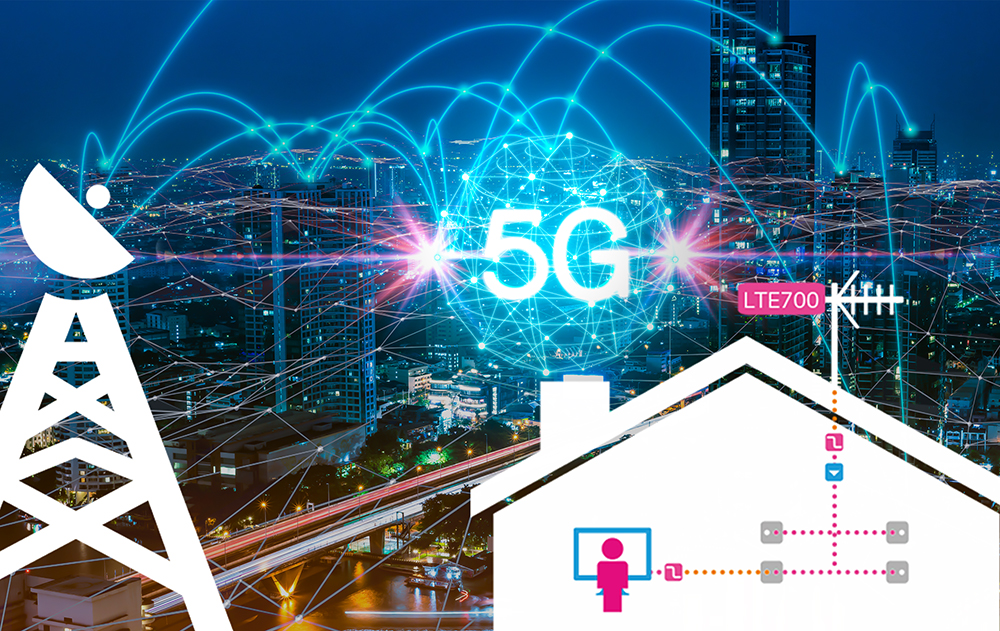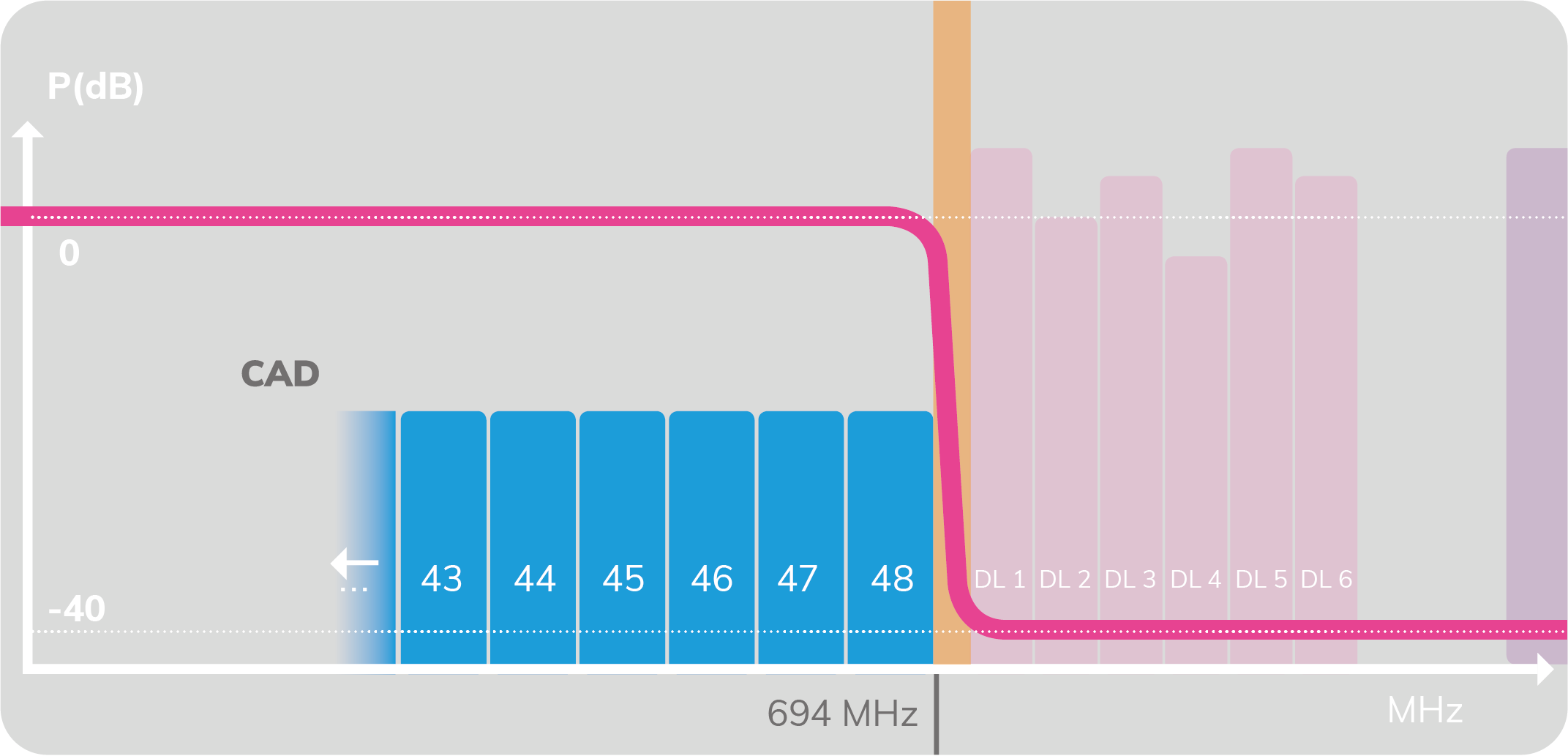ALCAD offers the sector its catalogue of solutions for interferences that can be produced by 5G in the LTE700 band
30/09/2021

The implementation of 5G networks will force the facilities to be prepared for the interferences that can occur in the LTE700 band. At ALCAD we recommend that professionals in the sector anticipate this problem to avoid last minute adaptations.
To simplify this task, we put at your disposal a catalogue of products that allow adequate filtering: antennas, filters, mast amplifiers, apartment amplifiers, head-end amplifiers or head-end amplifiers with SAT. A complete range of solutions that have already been used in other EU countries where there are already 5G emissions in the LTE700 band.
ALCAD is a world benchmark thanks to its complete Multimedia TV catalogue, which has already benefited more than 20 million people in 60 countries around the world. The robustness of our products, manufactured in Europe with a guarantee of quality and reliability, has made us specialist leaders in capturing, processing and distributing television signals.
Thanks to this background, ALCAD is ahead of the needs of this market niche with a wide catalogue of products that allow better filtering against possible interference from mobile telephony from channel 48 (700 MHz).
And it is that once the 5G networks are fully operational, these products will ensure a signal reception free of the problems that mobile phone repeaters can generate thanks to their 40 dB rejection of the LTE700 band, as can be seen in the following graph:

Relationship between TV and LTE700
What is LTE700?
5G is the name used for the fifth generation of mobile telephony. It is a new technology that allows data transfer rates between the user and the network of up to 10 Gb / s in download. This will allow UHD video streaming, faster data management in the cloud and a new network for the Internet of Things (IoT).
There are multiple bands of operation for 5G. It will first be implemented in the new 700, 3500 and 26000 MHz bands. Then in the 1500 MHz band, currently assigned to DAB. Finally, in the rest of the mobile telephone bands 800, 900, 1800, 1900, 2100 and 2600 MHz.
For Digital Terrestrial Television, the closest band and therefore by which it can be affected is the 700 MHz band, known as LTE700. This band comprises the frequencies 703-733 MHz for the upstream band, and 758-788 MHz in the downstream band.
Spectrum TV and LTE700
TV and LTE signals are in adjacent bands with a 9 MHz difference between the highest TV broadcast channel (C48) and the data upload band. Therefore, the separation of the two emissions is small in areas close to 694 MHz and adverse effects can occur throughout the UHF band.
The situation is not as complex as in the first Digital Dividend, because the LTE700 band closest to the TV band is the upstream one, from mobile to base station. In the first dividend, the closest band was the downstream band, from base station to mobile. The mobile emission powers are much lower than those of the base station.
However, a new critical situation arises inside the house, where the mobile phone can interfere with the TV tuner and the TV connection cable to the socket.
Intermodulation in broadband
The greatest effects of interference and intermodulation can occur due to broadband signals, a very high difference between the power levels of the signals generates a distortion in the band is the cause of the poor quality of the received TV channels. Faced with these problems, the solution is to filter the signal before amplification.
It is important to know that the affected TV signal is not reduced to the channels closest to the LTE broadcasts, but is extended to the entire operating range of the TV installation.
Interference from an LTE700 mobile phone
The mobile can also cause interference through the TV antenna, for example, when the mobile is close to the TV antenna. This case could occur mainly in single-family homes, rather than in buildings.
Filtering the LTE700
How to solve the problems produced by these interferences? The first step is to filter the LTE700 and LTE800 signals received by the receiving systems. This is to eliminate signals from occurring throughout the UHF band. In this way, it is intended that Digital Terrestrial Television does not affect its quality and signal level in reception and distribution.
What elements should be introduced to solve these problems?
- Installation of TV connection cables with high shielding.
- Installation of filters next to the TV to avoid interference from LTE700 signals in the data upload band.
- Antennas compatible with the emission of LTE700 telephony signals.
- Filters immediately after reception and before signal amplification.
- Protection of the distribution installation with connectors and shielded coaxial cable against external interference.
Signal reception systems
The antennas with rejection for LTE700 telephony emissions receive the Digital Terrestrial Television signal in an operating band that goes from 470 to 694 MHz.
With the installation of this type of antennas, the effects caused by the reception of LTE700 and LTE800 signals in DTT facilities are largely mitigated. The behavior of the antennas compatible with LTE emissions will differ as their selectivity is higher or lower. In either case, the objective is to perform a first filtering of these signals.
Signal filtering
The most effective way to protect the signal in most installations, eliminating the emissions of LTE700 and LTE800 mobile phone signals in TV distribution, is with the introduction of low-pass filters with high selectivity in the nearby frequencies. at 694 MHz.
This type of filter can be installed both with antennas compatible with LTE700 emissions, as well as in those installations carried out previously and that want to adapt to the new disposition of the radioelectric spectrum.
LC filter
It is a type of filter that allows the rejection of the LTE700 and LTE800 bands. They are filters with a wide rejection band that reject all bands above the cut-off frequency of 694 MHz. The guard band with respect to the LTE700 downstream band is 64 MHz, which guarantees a high rejection with filters of type LC.
The guard band with respect to the upstream band is 9 MHz, which is also sufficient for LC-type filters, taking into account that the emissions from mobiles in this band are much less powerful than those that the stations would have. base.
Any questions? Please contact us. We will be happy to help you.
More information:
ALCAD Home | 5G Solutions Catalogue - LTE700 band pdf 3.5 MB
